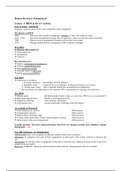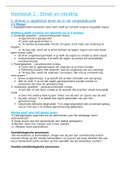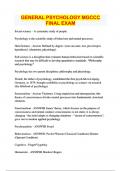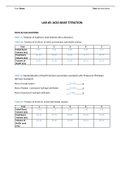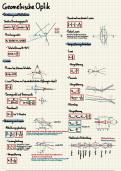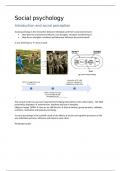Takeaways from the book
Chapter 2
Bootstrapping: founding and running a company using only personal finances or operating revenue.
This form of financing allows the entrepreneur to maintain more control, but it also can increase
financial strain.
Owners can bootstrap by cutting costs, personally financing operations, cutting back operations,
or looking for other creative short-term financing solutions.
Entrepreneurial character traits: The quality of creativity (eight dimensions):
1. High need for achievement 1. Abstraction
2. High need for autonomy 2. Connection
3. Internal locus of control: they control their 3. Perspective
own success or failure; success or failure
4. Curiosity
is not the result of chance or fate
5. Boldness
4. High levels of creativity
6. Paradox
5. Willingness to take measured risks
7. Complexity
8. Persistence
Chapter 3
New venture paradigms: Symptoms of change:
1. Copy-cat strategy (incremental): implies that you The unexpected, incongruity,
will have to compete primarily on price, and this inadequacy in underlying processes
means that the business is likely to have low
Changes in industry
profitability and limited growth potential
Changes in market structure
1ZM20 - course summary 1
, 2. Incremental product/service innovation Demographic changes
(incremental)
Changes in perception
3. Market expansion (incremental)
Changes in mood
4. Disruptive innovation (radical)
Changes in meaning
5. Market paradigm shift (radical)
→ You can challenge industry paradigms by
questioning sectoral, performance and customer
conventions
6. New-to-the-world industries (radical)
Developing ideas involves creativity → Spotting opportunities (techniques):
improve creativity by developing
Brainstorming
discovery skills:
SLEPT analysis: Social, Legal, Economic,
1. Associating
Political & Technological factors
2. Questioning
Mind mapping
3. Observing
Futures thinking: cross-disciplinary approach to
4. Experimenting considering potential futures through the
exploration of trends and drivers for change that
5. Networking
may lead to different future scenarios
Analogy
Attribute analysis
Gap analysis
Chapter 4
Total Available Market (TAM): the size of your potential The profitability of individual companies
market (i.e., those who might be interested in buying within an industry can vary widely, implying
your particular product) → This reflects the total sales of that your choice and, just as important,
competing products. execution of strategy is probably more
Served Available Market (SAM): the size of the target significant than your choice of industry.
market segment you wish to serve within the TAM.
Penetrated market: the size of the SAM you actually
capture.
Market share: penetrated market divided by SAM.
Chapter 5
Supply push: occurs when you create incentives Demand pull: occurs when you create incentives
to intermediaries in your distribution channels to directly with end-use customers who then 'pull' the
sell your product. product through the distribution channels.
Chapter 6
1ZM20 - course summary 2
, Values and beliefs: set expectations for how to Value-driven marketing: seeks to develop
operate and treat people - customers, employees, customer relationships and is usually underpinned
partners and suppliers. by a strong brand identity.
Vision statement: shared mental image of a Mission statement: statement of purpose for your
desired future state. business, underpinned by your values.
Corporate Social Responsibility (CSR): As well as being worthwhile in its own right, CSR can be used
to underpin your brand identity by providing evidence of your values and beliefs.
Chapter 8
The strategy with the best chance of generating sustainable growth and the highest profits:
differentiate with the aim of dominating your market as quickly as possible, and continue to innovate
around that differential advantage.
1. Differentiate
2. Dominate
3. Innovate
Chapter 10
High level operating plan: provides details of the Gantt chart critical path: the longest path
key pre-launch and operational activities and through the chart, i.e., the shortest possible time
highlights the critical success factors. to complete the task
→ These key activities and their completion
dates become your operational objectives.
Chapter 11
Breakeven point: the benchmark above which the business starts to make a profit.
It measures the risk the business faces
Critical success factors: the key Strategic options: the Upside risk: the
activities that are crucial to the contingency plans you have in uncertain possibility of
success of your venture. place should things go wrong. gain.
Chapter 12
The less stable and predictable the The appropriate structure is 'organic':
environment you operate in and the
Highly flexible, ever changing, with limited hierarchy
more complex the tasks you face, the
greater the autonomy you should Places greater emphasis on personal relationships and
give your staff. interactions than on structures
Power is decentralized and authority is linked to
expertise, with few bureaucratic rules or standard
procedures.
→ Culture is very important in providing direction.
1ZM20 - course summary 3
, Chapter 13
No extra comments.
Chapter 14
Deciding on the nature and source of finance as strategic decision for start-ups:
Fixed or permanent assets should be financed with equity, medium- and long-term bank finance or
lease/hire purchase
Working capital can be financed by short-term loans and factoring, with fluctuations financed by
overdraft
→ Match the term duration of the source of finance with the use to which it is put.
Chapter 15
Profit: measured by sales/turnover minus Financial drivers: headline measures of the financial
total costs. performance of a business:
Represented by the growth in all the Cash
assets owned by a company.
Sales
Profit is not the same as cash flow
Profit margins
→ you can be profitable but illiquid
Margin of safety
A new venture needs to plan and
monitor cash flow carefully as it Productivity
moves through 'Death Valley' Debtor/receivables and/or stock/inventory control
→ Quick and easy to calculate and monitor.
Ratio analysis: allows you to assess your financial performance, compared to industry norms or to
assess trends overtime.
Can be based both on forecast and actual financial information
Introduction
Start-up: an organization designed Decision-making approaches:
to search for a repeatable and Causal approach: more planning & predictive-based
scalable business model (Blank,
2013). Effectual approach: more adaptive & flexible
→ More-often used by expert entrepreneurs
Conceptual domain: Business Model Canvas:
1ZM20 - course summary 4



